On Wednesday, Feyenoord will face Roma in the first-ever UEFA Europa Conference League final. Feyenoord are still the last Dutch team to win a European title, having won the UEFA Cup in 2002. On the other hand, Roma look to win their first-ever European trophy and end the club’s 14-year trophy drought. Led by star striker Cyriel Dessers, who’s scored 22 goals this season, Feyenoord have the best attack in the Conference League. On the other hand, Tammy Abraham has scored 30 goals this season, leading Jose Mourinho’s attack.
In this tactical analysis, we examine both teams’ tactics and trends throughout this season to determine how they will match up. It will also be an analysis of the strengths and weaknesses of both teams which may prove decisive on Wednesday.
Lineups
Both managers have been extremely consistent with their starting elevens. For Feyenoord, Marciano has been in goal with Geertruida, Trauner, Senesi, and Malacia at the back. Aursnes and Kökçü are usually the two central midfielders with Til in the number 10 position. Nelson is a traditional winger on the right while young star Sinisterra is an inverted winger on the left. Up top, Dessers is the centre-forward. They have been extremely consistent with their 4-2-3-1, using it 84% of the time in 2021/22.
As far as Roma are concerned. Mourinho has consistently opted for a 3-4-2-1 in the second half of the season. Rui Patrício is the keeper with Gianluca Mancini, former Manchester United defender Chris Smalling, and Roger Ibañez as the centre-backs. While Leonardo Spinazzola has recovered from injury, Rick Karsdorp and Nicola Zalewski should still be the wing-backs in the final. Sergio Oliveira and Bryan Cristante are the midfielders with Nicolo Zaniolo and Lorenzo Pellegrini ahead of them. Finally, Tammy Abraham is the centre-forward. This 3-4-2-1 can easily turn into a 3-4-1-2 with Zaniolo or Pellegrini joining Abraham up top.
Statistical overview
While both teams have rather attacking tactics, there are a few differences which will prove decisive in this match. The aim of this section is to identify the general behaviour and characteristics of both teams through data analysis in order to determine how the match will go.
These are two of the best attacks in the Conference League, but their structure and behaviour in possession are slightly different. First, Feyenoord prefer a bit more of controlled possession. They average an impressive 529.28 passes per 90 in the 2021/22 season with 57.91% average possession. Furthermore, only 9.32% of their passes are long with an average pass lass length of 19.41m. They average 38 positional attacks per 90, highlighting their volume and general dominance in matches. While they enjoy possession, they are not afraid to be direct, averaging 80.57 progressive passes per 90 and are constantly seeking to break lines and progress through the zones. As far as output, they are able to create a high volume of chances. Feyenoord average 16.72 shots per 90 with an average shot distance of 18.2m, fairly impressive. Additionally, they have scored 2.17 goals per 90 from exactly 2 xG per 90. Their 8.05 PPDA is what ensures this dominance of possession.
On the other hand, Roma’s statistical profile slightly varies. Starting with a PPDA of 11.92, they are not as dominant as Feyenoord. They average 100 fewer passes than Feyenoord with 429.12 passes per 90 and a 48.83% average share of possession. A slightly higher 10.57% of their passes are long with 66.32 progressive passes per 90. With only 26.77 positional attacks per 90 and an average pass length of 20.1m, their attack does not have as much volume or control as Feyenoord’s. At any rate, they are still incredibly effective in possession. While only averaging 13.72 shots per 90, they have maintained an xG per 90 of 1.82, an average of 0.1327 xG per shot compared to Feyenoord’s 0.1196. Their average shot distance of 17.6m is also better than Feyenoord’s 18.2m. Without as much volume as Feyenoord, Roma have been slightly more efficient in attack.
In conclusion, both teams have very good attacking systems. Both are extremely efficient, but Roma have a slight edge while Feyenoord have much more volume. With each teams’ general profiles identified, it is now time to look at some factors that will dictate the match.
Feyenoord’s high press
Throughout the 2021/22 season, Feyenoord have maintained a very high PPDA of 8.05. This high press system has allowed them to recover the ball very quickly and often dominate possession. On Wednesday, Feyenoord’s ability to relentlessly press Roma’s build-up will most likely see them dominate possession, at least in the first half. Whether this high press is successful or not will be very important in determining how the game will go. If so, Feyenoord will control possession and Roma will not have much time with the ball. On the other hand, if Roma are able to play through, or at least exploit, this high press, they will be able to create very good chances.
It is clear that Feyenoord’s pressing will be decisive, but it is important to understand how they press. They maintain their 4-2-3-1 structure while pressing high up the pitch. Arne Slot’s side do not adapt to the opponent’s structure and press man-to-man. On the contrary, they move as a unit with a zonal marking system. The image below illustrates their structure while pressing.

Their star centre-forward, Dessers, is a key factor in their pressing. His work rate is very impressive as he leads the press. Once the opposition plays to a side, Dessers will press the centre-back while cutting off the other. Due to the angle of his run, he is able to cut off a passing lane and consequently mark two players at once. In the example below, he is pressing the goalkeeper after he receives the ball. He angles his run to cut off the other centre-back and force the goalkeeper one way. While he does so, Nelson is already pressing the other centre-back.
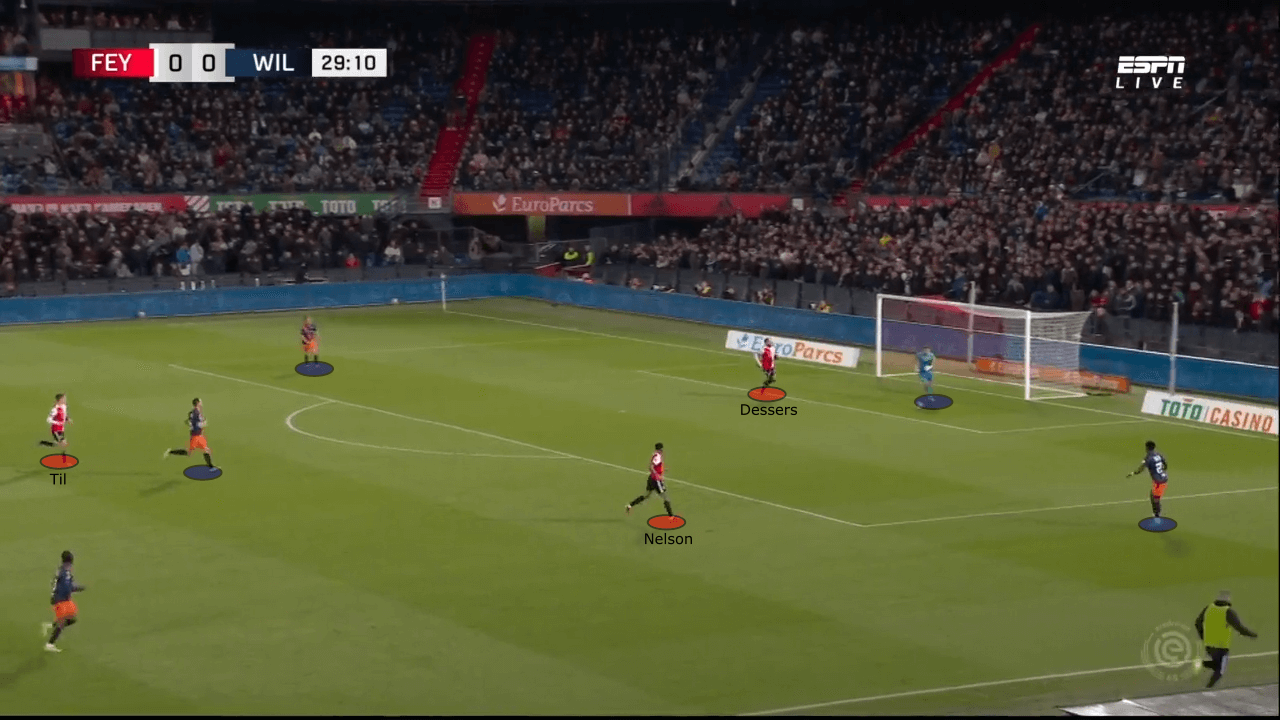
The central attacking midfielder also has an important role in their high press. In the example above, Nelson was able to press the other centre-back who will receive the ball. However, that is often not the case as the winger is usually busy with the fullback. This is where the attacking midfielder comes in. Generally, he will sit behind Dessers, on the opposition’s defensive midfielder. However, if the ball is played across, as seen below, he will often leave his man and press the centre-back.
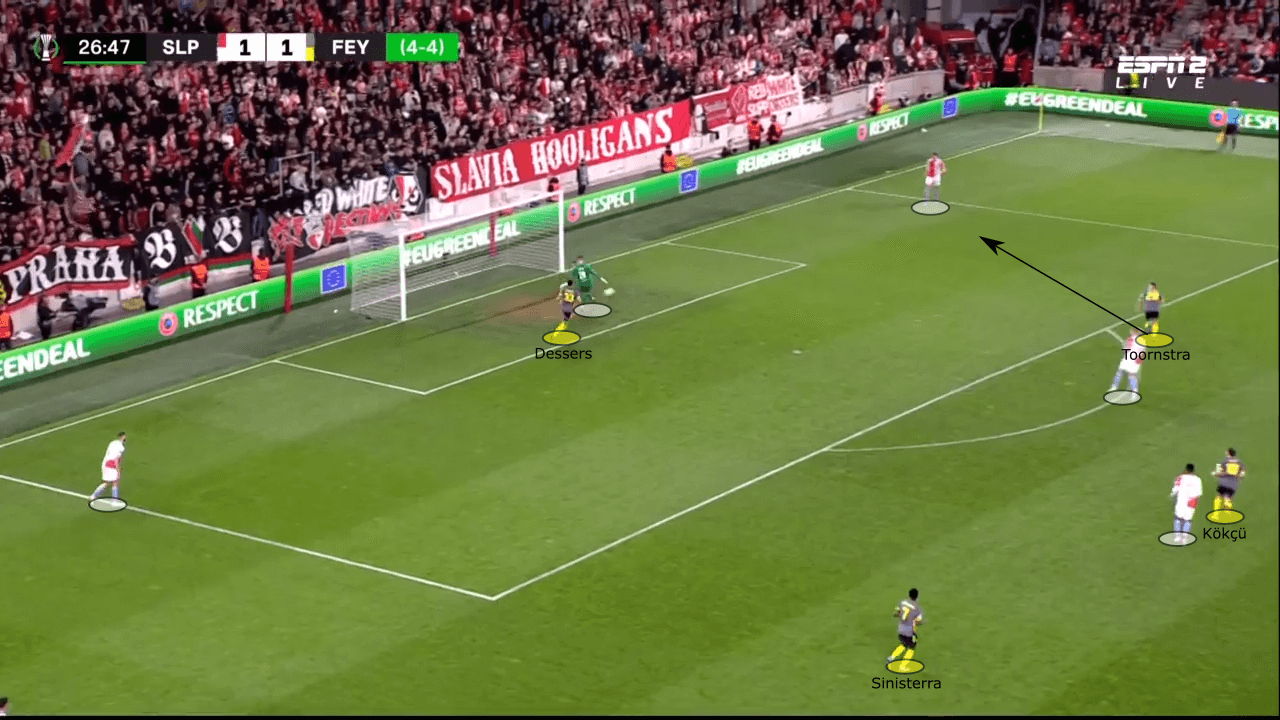
Another example of this behaviour can be seen below. This switch helps Dessers and ensures the intensity of the press is constantly high. It also gives the centre-backs less time on the ball and maintains the chaos created by the press.
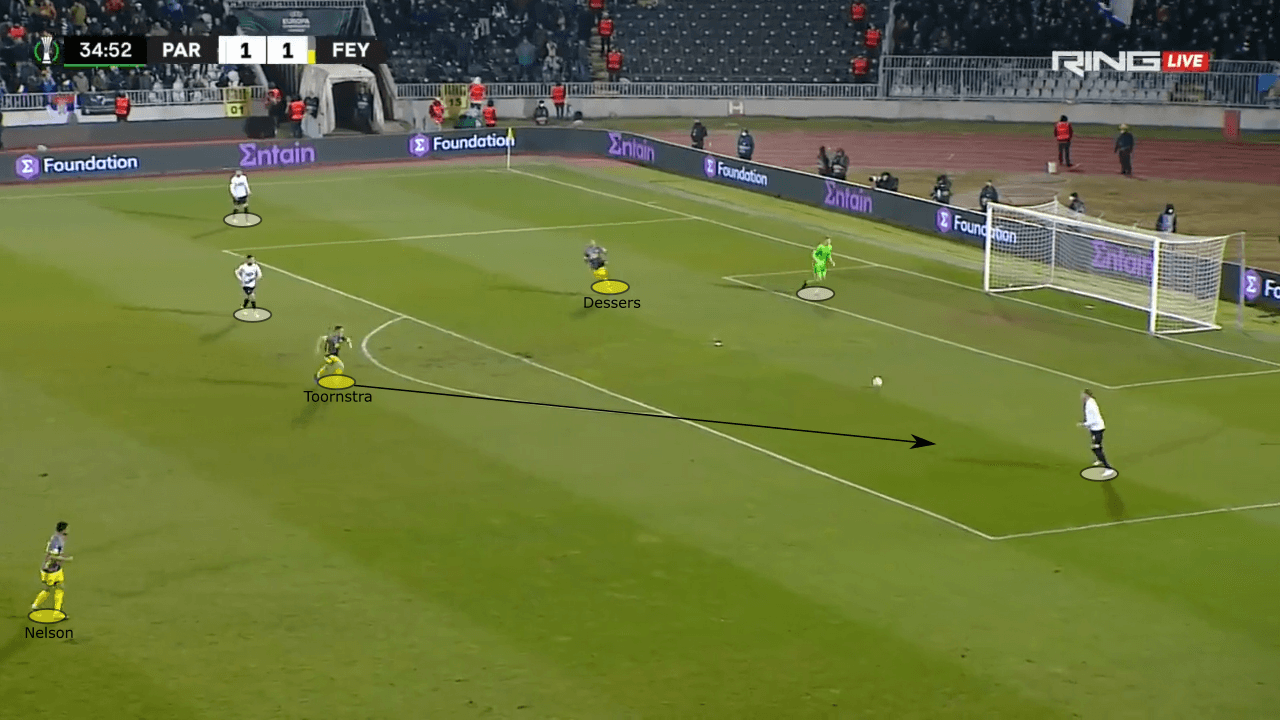
It is very impressive how they compress the pitch and suffocate the opponent, especially in slightly lower blocks. As stated, they maintain their structure and move as a unit. In the example below, they are able to compress the pitch in half and congest the opposition’s playing area.
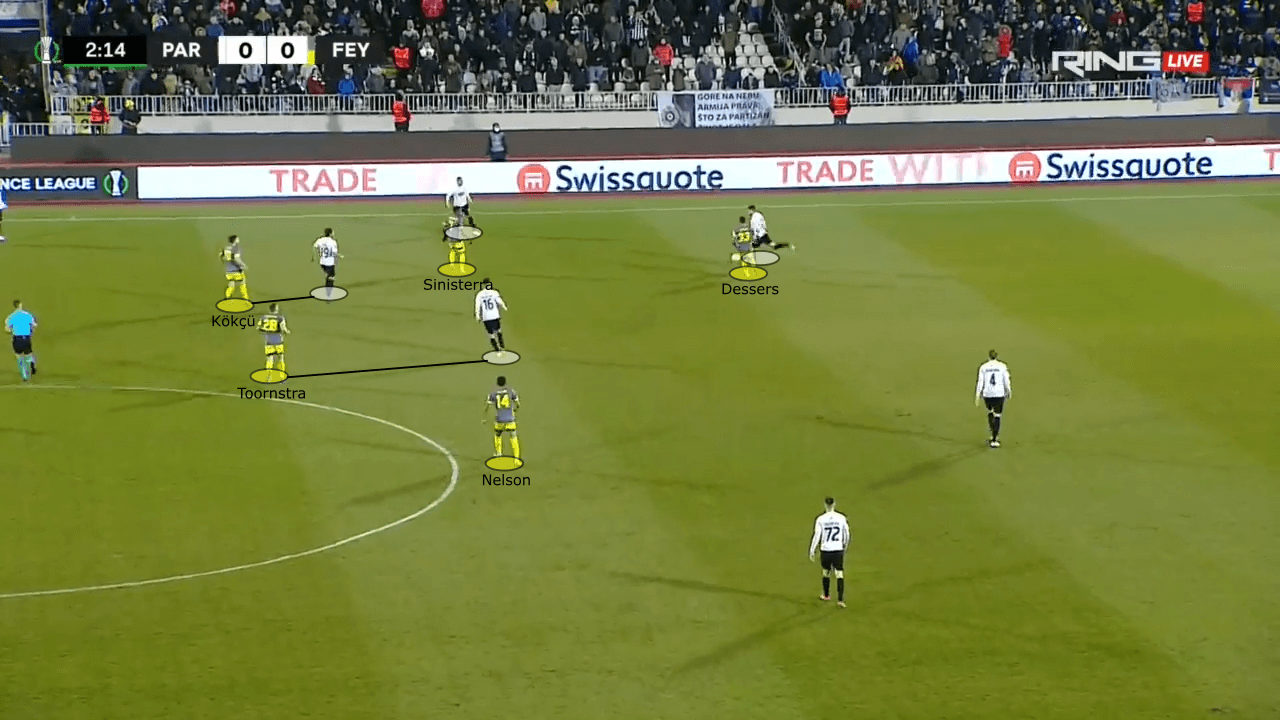
How Feyenoord attack
Feyenoord will most likely have more of the ball, so it is important to understand their structure in possession. Despite playing in a 4-2-3-1, players have varying roles, and through their behaviour, they create a sort of asymmetrical shape. The roles of the fullbacks are extremely important in this system. Their four main wide players have varying characteristics, each with a different role. On the right side, Nelson is not a common inverted winger as he is right-footed. Consequently, he plays the role of a traditional winger and provides width. As a result, their right-back, Geertruida, will drift inside and play as a midfielder. In the example below, Geertruida pushes high and drifts inside, dragging the opposition left-back with him. This movement leaves Nelson completely alone in the wide channel.
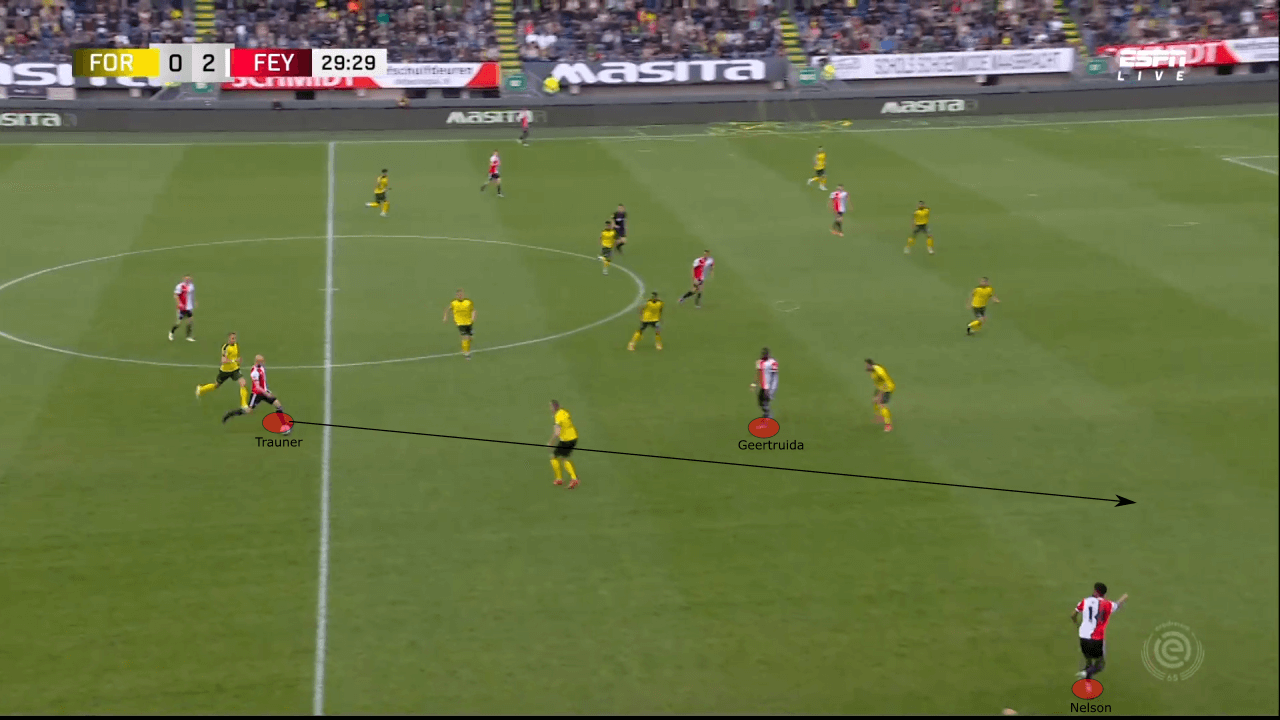
Another effect of this behaviour is that it provides an extra man in the midfield. Whether in the build-up or middle third, this successfully creates an overload which complements their style of play. In the example below, Geertruida is able to form a 2v1 scenario with Aursnes and advance into the middle third.
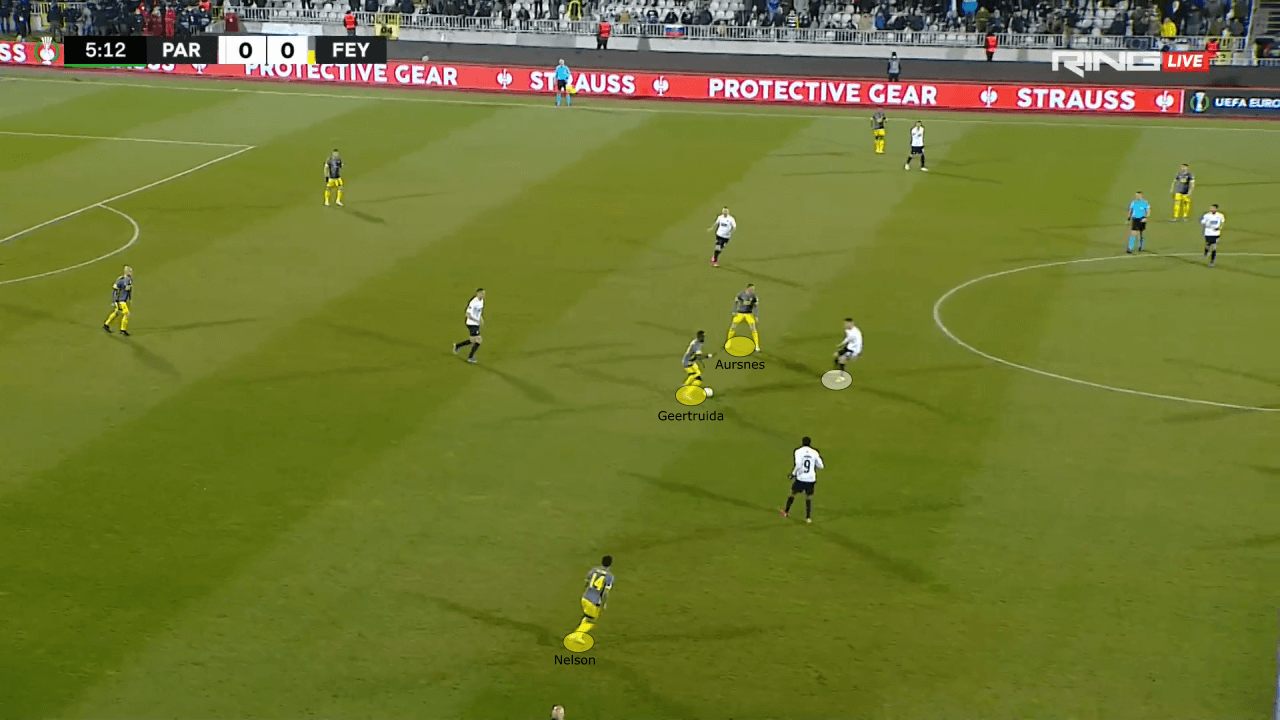
Geertruida’s heatmap in the 2021/22 season further illustrates this behaviour. In his own half, he almost plays like a defensive midfielder.
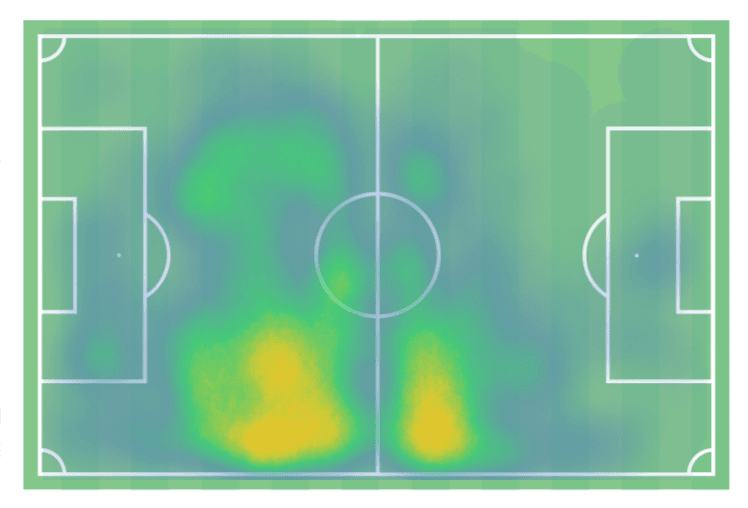
Their structure on the left side is the opposite. Sinisterra plays as an inverted winger and often drifts centrally to combine with Til or Dessers. While he drifts inside, Malacia will maintain the width and frequently create overlaps.
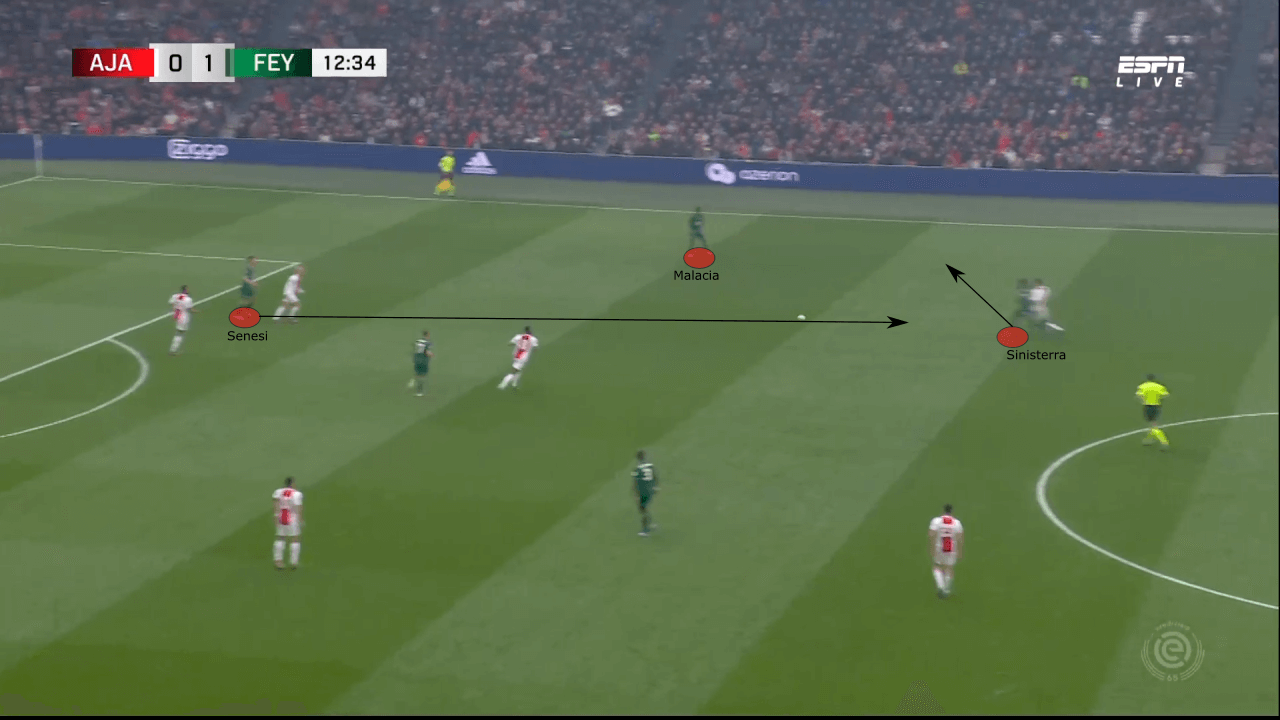
As noted, progressive passes are a key part of Feyenoord’s attacking system. They are constantly looking to break defensive lines through their movement and positioning. They are fairly effective in doing so, completing 80.5% of their 80.57 progressive passes per 90. In the example below, Kökçü’s movement within the defensive organisation allows Senesi to successfully find him.
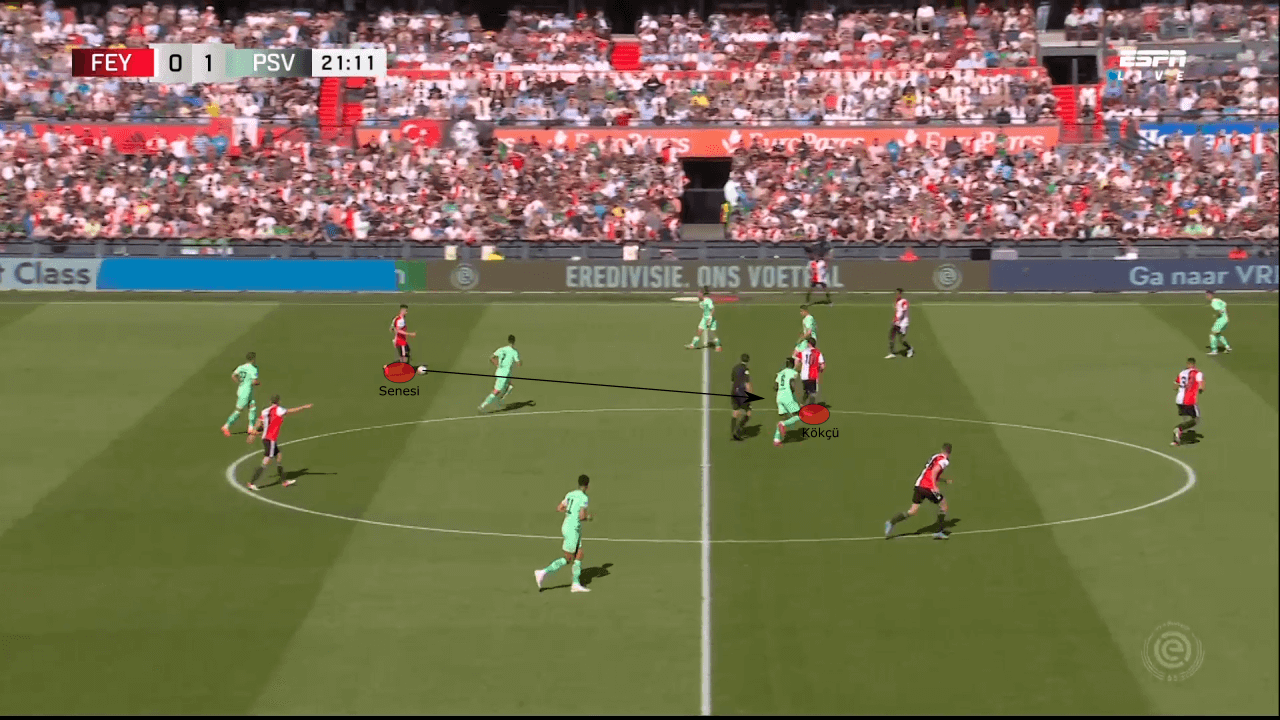
After receiving, Kökçü drives forward before playing a through pass for Dessers behind the defensive line. With two vertical passes, they were able to play through PSV’s whole defensive organisation.
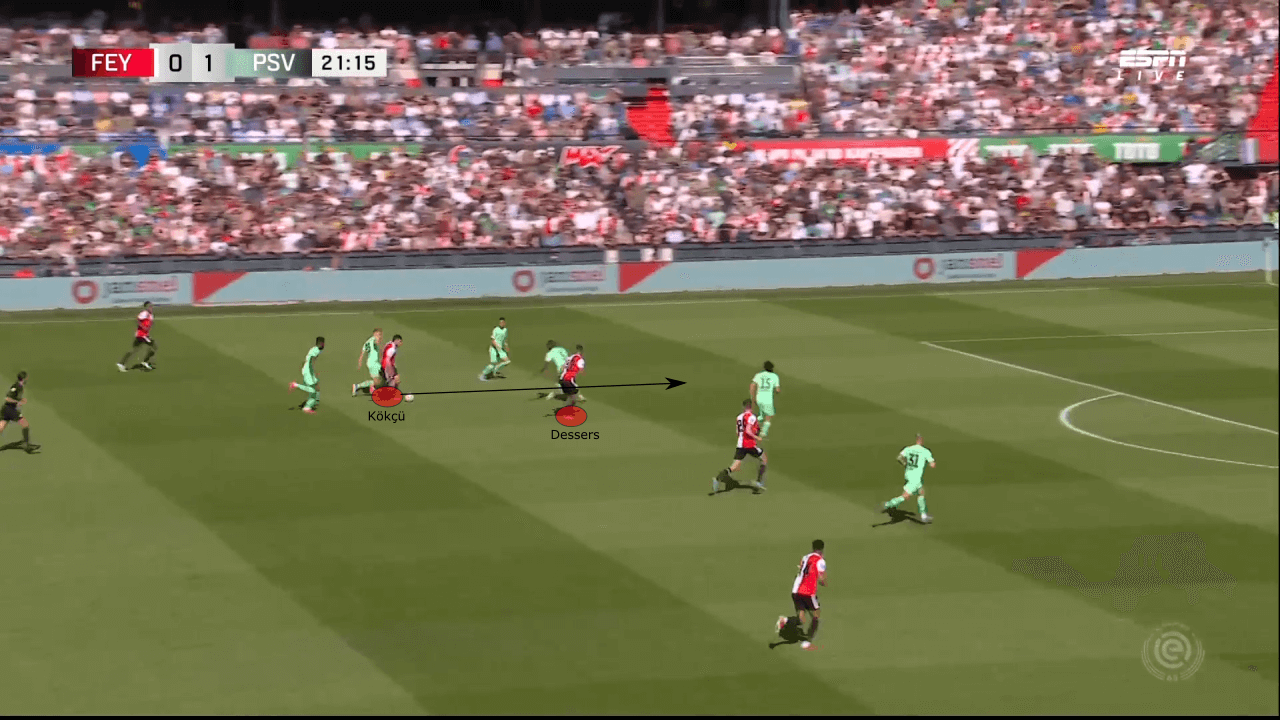
Now against a low block, the same principle is used. Centrally, Geertruida is able to find Jahanbakhsh behind the opposition’s midfield line.
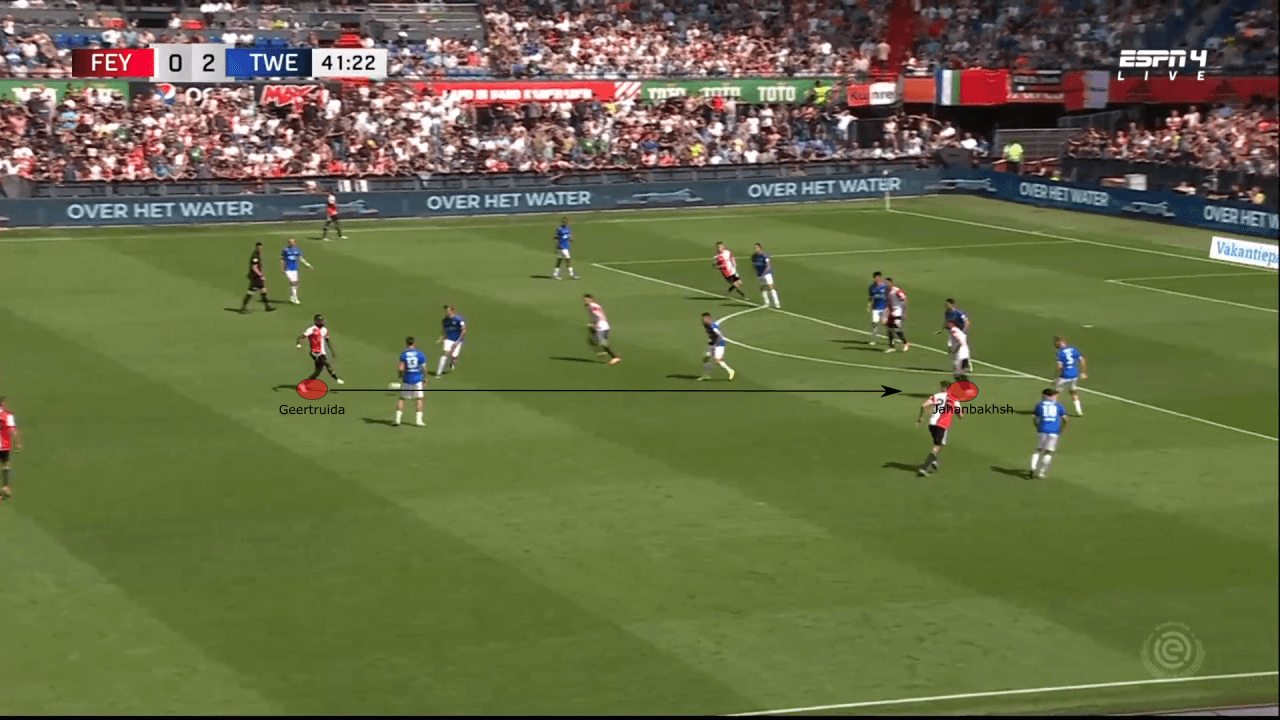
Jahanbakhsh instantly plays it back to Geertruida, who plays it forward again to Dessers. Dessers is extremely effective at receiving with his back to goal, especially inside the box. By constantly combining and playing vertically, they are able to progress through the pitch and create chances.
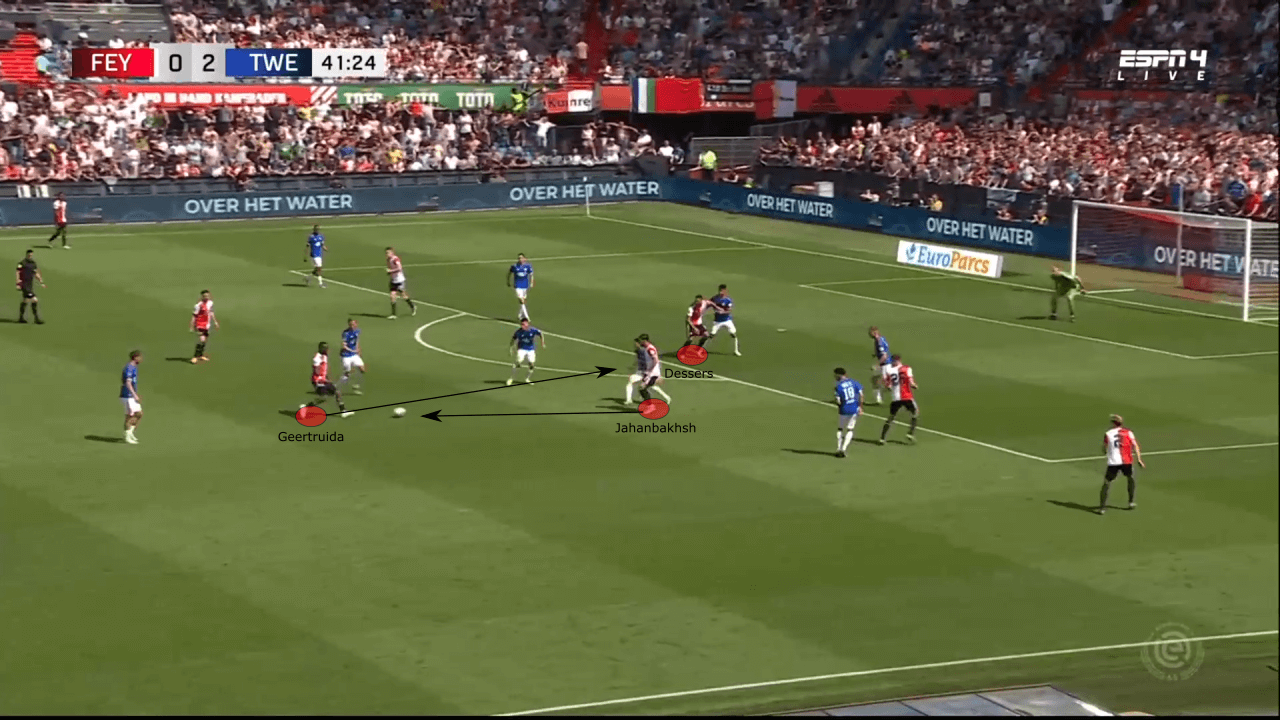
From the left wing, they are able to combine inside to create a chance. This time, Malacia and Sinisterra invert their roles as Sinisterra remains wide while Malacia drifts inside. Kökçü plays it inside for Til who plays Malacia with just one touch. Feyenoord’s system is heavily reliant on approximation and combinations. Players are constantly moving the ball and combining to break lines.
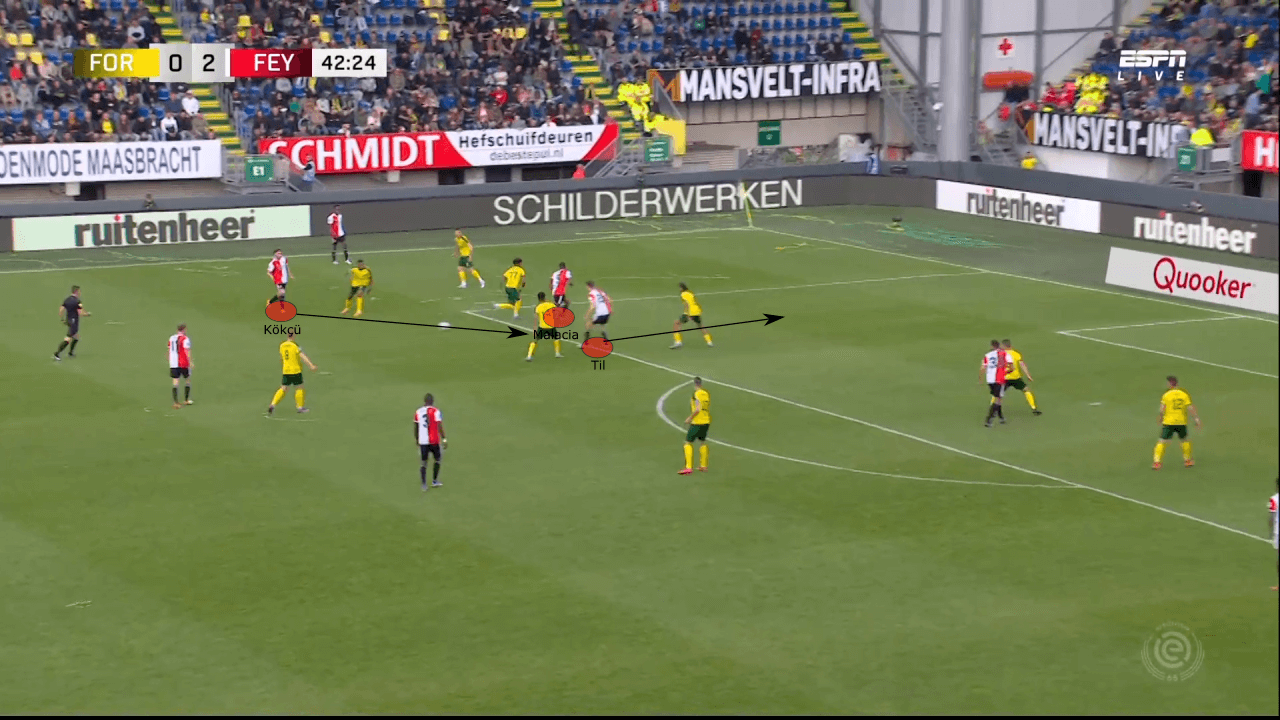
Roma’s weakness
Mourinho is widely known for building extremely efficient defensive systems, sometimes almost to a fault. While Roma have been generally good defensively under Mourinho, conceding just 1.06 xGA per 90, there is one key area which Feyenoord must exploit. In the second half of the season, Mourinho has constantly switched between a 3-4-2-1 and a 3-4-1-2. While their front three’s structure may vary in possession, they set up in a 5-2-1-2 out of possession, with Pellegrini often being the lone attacking midfielder. Against Leicester City, we are able to identify this defensive structure.
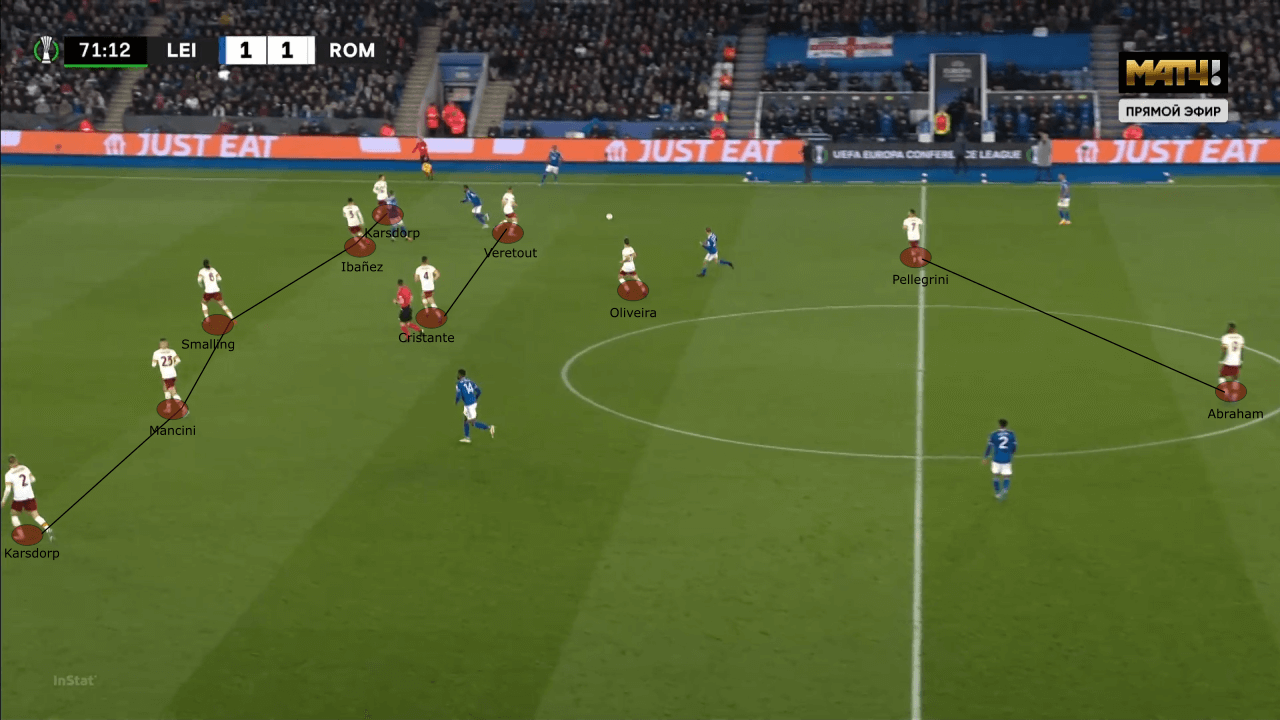
While it has its strengths, this structure leaves them very vulnerable in the midfield. With only Cristante and Oliveira in this area, Feyenoord must exploit this. The key lies in creating overloads centrally and manipulating space. In the instance below, two Leicester players are able to pin Roma’s midfielders, leaving a significant gap for James Justin to receive the ball.
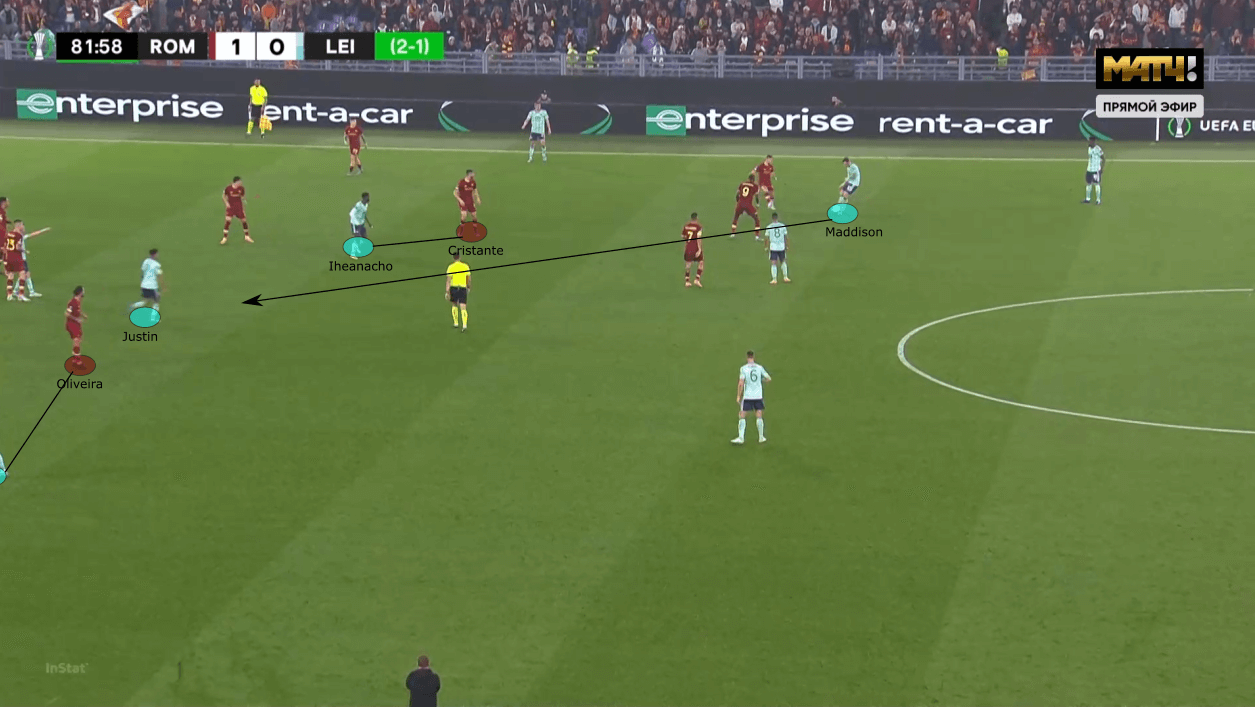
In a similar scenario, Roma’s midfielders are occupied by two Leicester players. As Cristante drifts wide to mark Pereira, Maddison takes advantage of the space left and checks in to receive the ball. As a consequence, Ibañez has to either step up and close him down or sit and maintain their structure. He chooses the former, leaving a dangerous hole in the backline. While Leicester did not exploit this here, the opportunity was there. By manipulating the midfielders and disorganising the defensive organisation, Feyenoord will be able to exploit key spaces within Roma’s defensive structure.
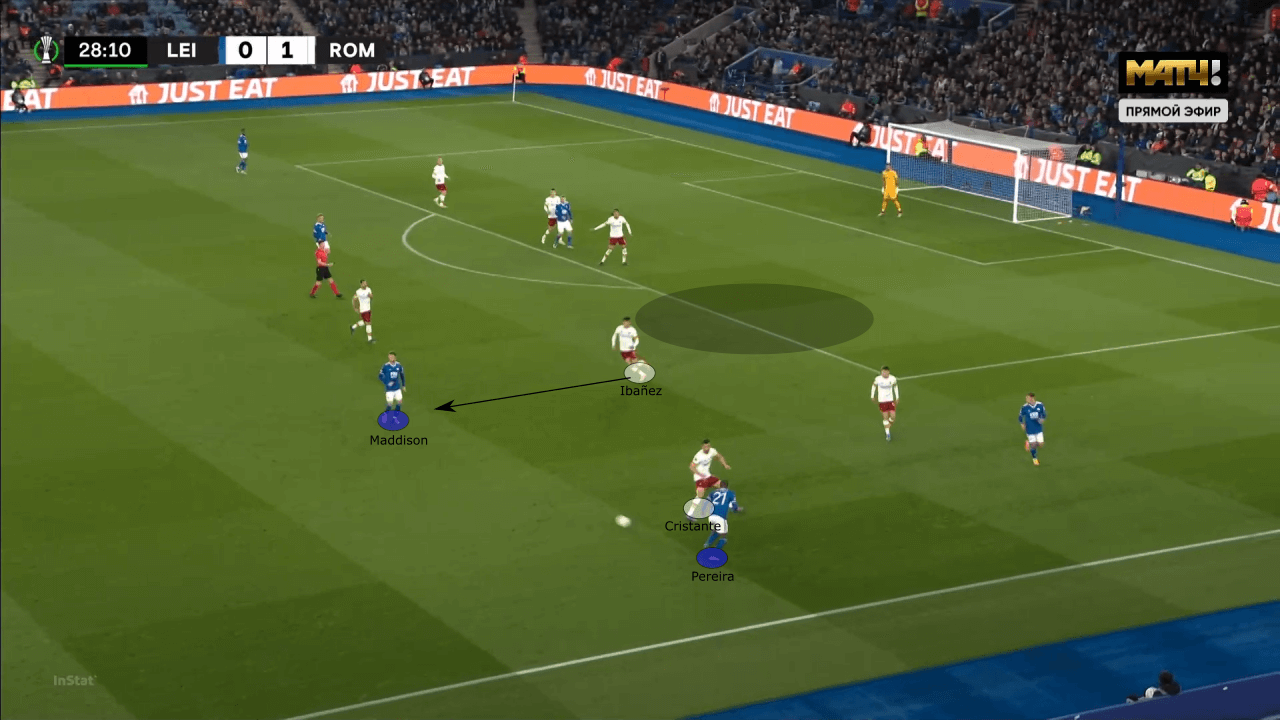
In the instance below, Inter was able to successfully manipulate and disorganise Roma’s defence to create space. After playing wide, Dimarco makes a run deep into Roma’s half. By doing so, he drags Mkhitaryan with him.
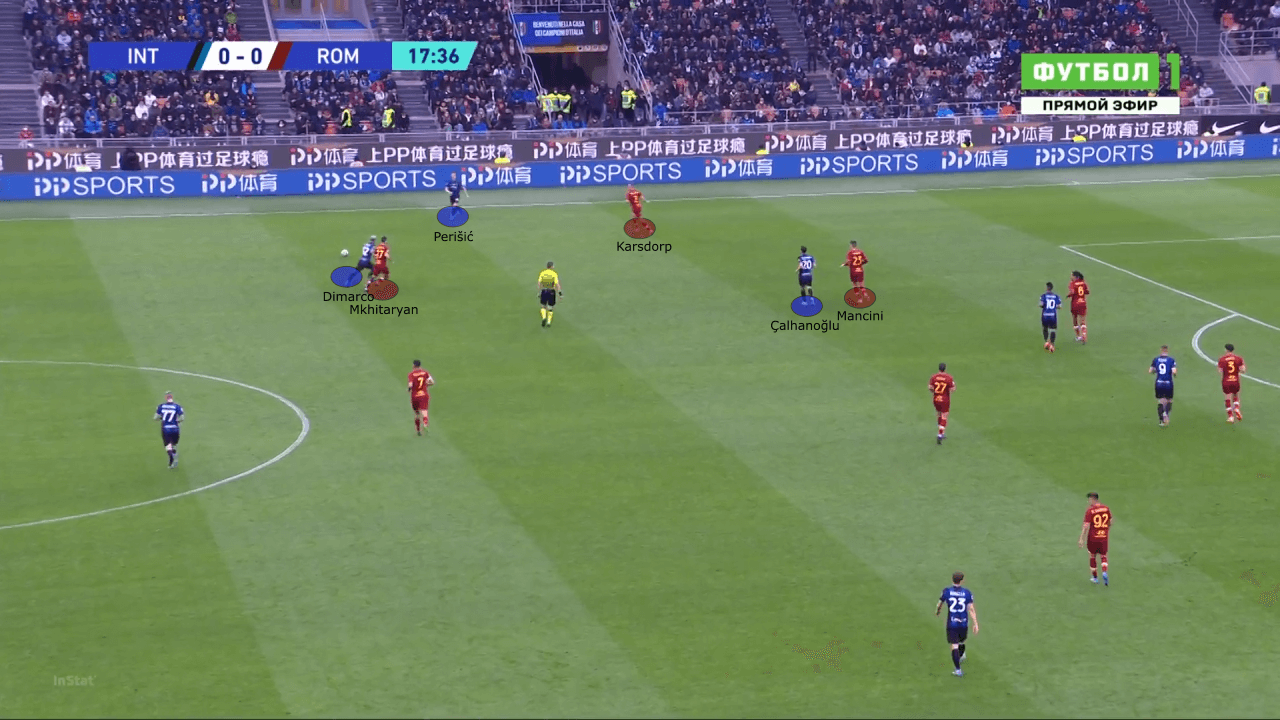
With the other midfielder, Oliveira, far away, Dimarco creates a hole in Roma’s midfield that Çalhanoğlu takes advantage of.
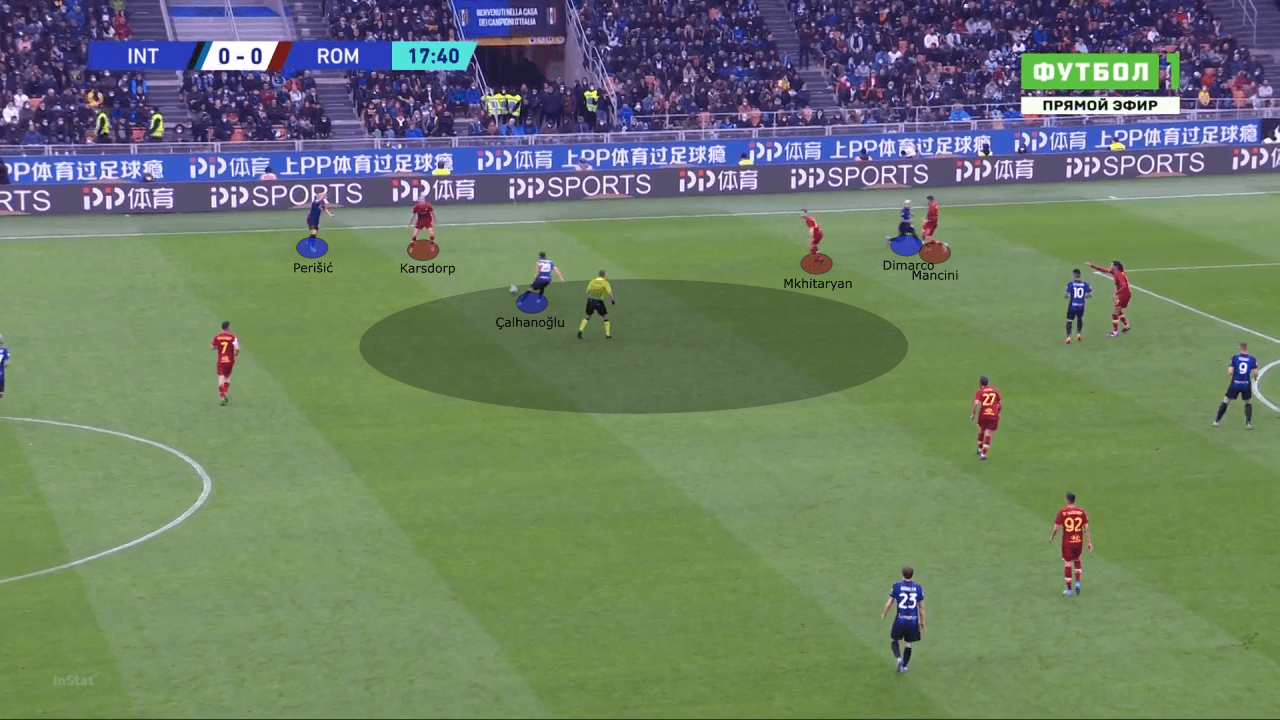
Roma’s weakness lies in their midfield. With only two players occupying the space and little to no help from Pellegrini, this area is key for Feyenoord to exploit. Feyenoord must look to create overloads, especially with Geertruida drifting inside. By pinning and manipulating Roma’s midfielders, they will be able to create key spaces to exploit. If Feyenoord successfully exploit this, it may prove fatal for Roma.
Roma’s edge
Roma have not had much attacking volume under Mourinho, and this trend should continue in the final. With Feyenoord looking to press and dominate possession from the beginning, Roma will not have much of the ball and must be extremely effective with the few opportunities they have. Feyenoord’s defensive structure has two key weaknesses which Roma must exploit should they want to become champions.
Whether in transition or by playing through their high press, Roma must exploit Feyenoord’s high defensive line. Their defensive line is extremely high, and a significant portion of the goals they concede comes from teams exploiting this. Below, for instance, Fortuna is able to create a very good chance in transition as Feyenoord’s defensive structure is highly disorganised.
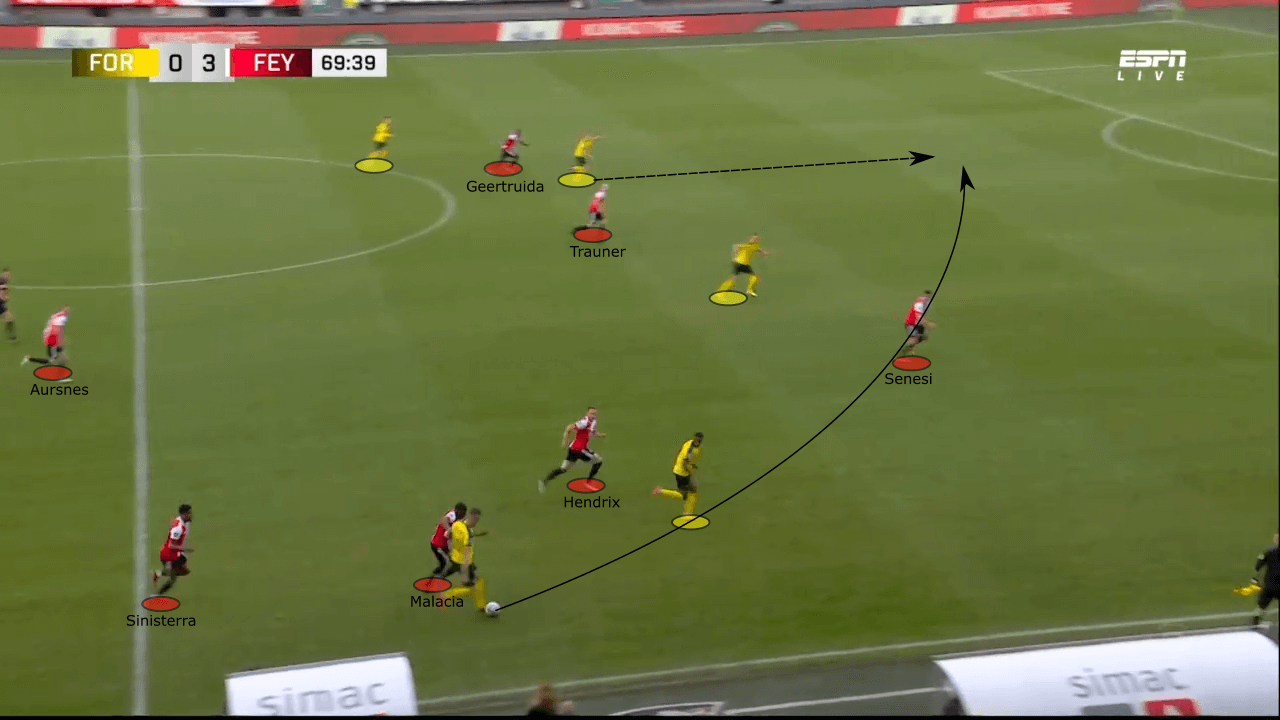
In another instance, PSV’s midfielder plays a long ball behind the defensive line. As they maintain a high line, there is a lot of space to be exploited. Roma’s forwards must constantly attack this space with runs.
Attacking the depth has three general effects. Obviously, if successfully played through, the player will receive the ball in a perilous position. If not, he will drag the defensive line deeper into their own half, creating space in the midfield. In addition, he will drag defenders and disorganise the defensive structure.
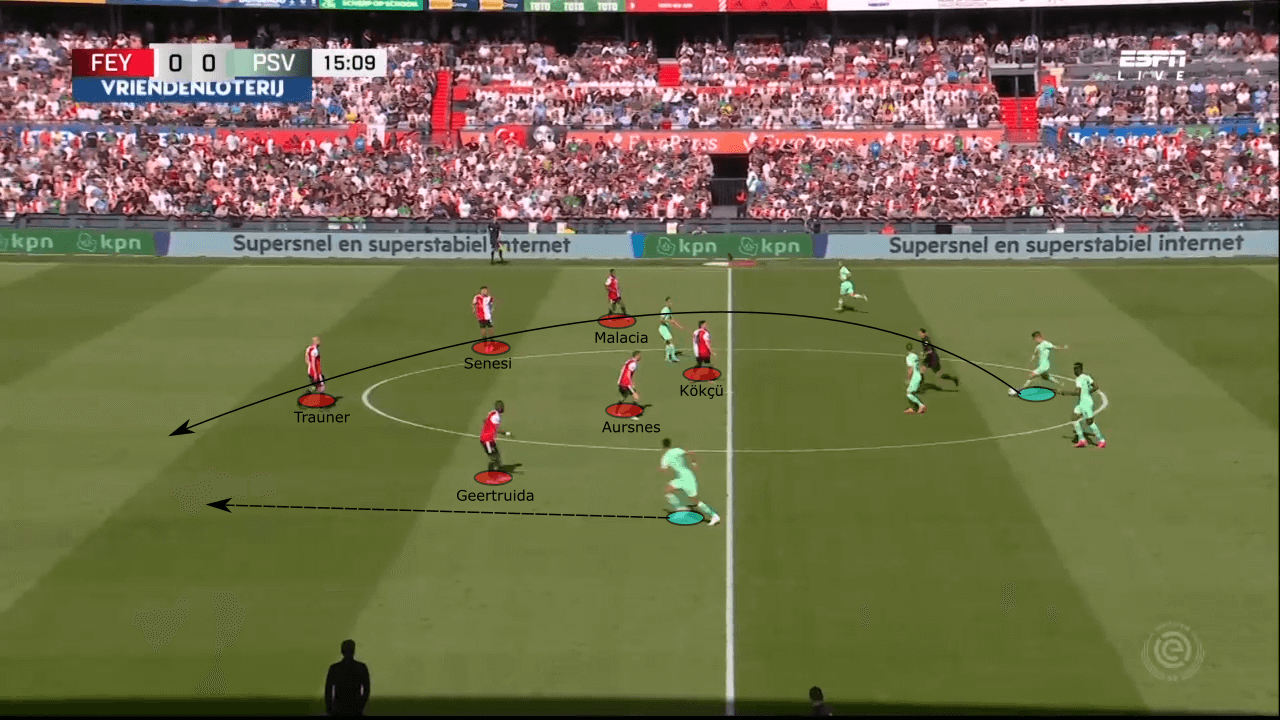
Another significant portion of the goals Feyenoord concede comes from wide areas. Luckily, this is a key strength of Roma’s attack. In the instance below, for example, Shomurodov cuts it back for Karsdorp in this example. He notices Mkhitaryan coming in from behind and leaves it for him to score Roma’s first.
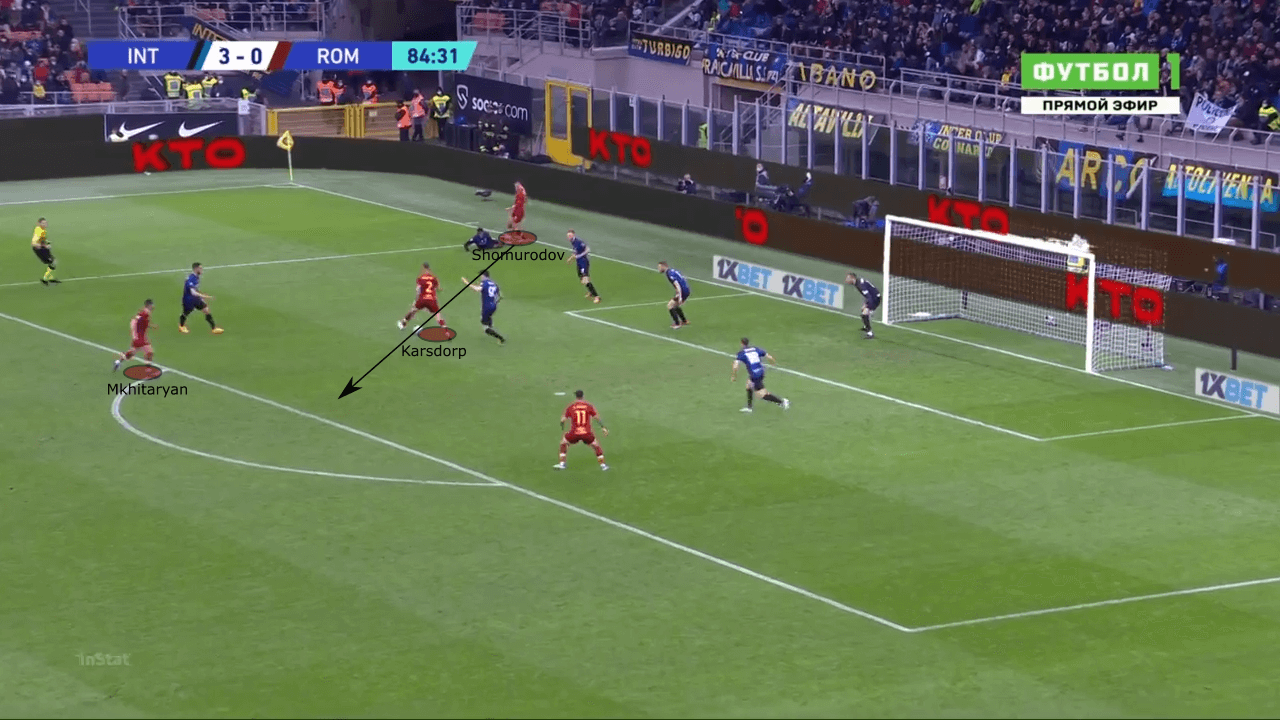
Perhaps Roma’s biggest weapon is Abraham. Not only is the English a significant goalscoring threat, but his intelligent movement inside the box also creates chances for others. In the instance below, he uses his body to lay El Shaarawy off after receiving a cross.
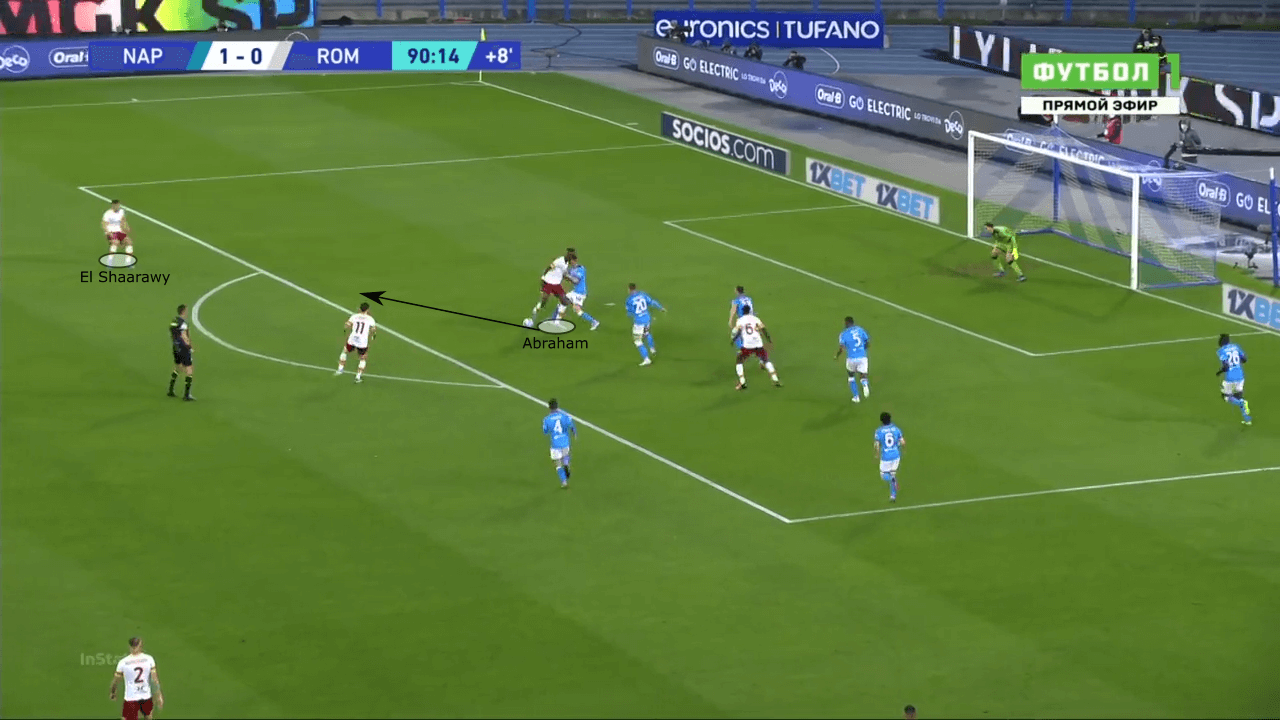
Roma will also wish to create overloads in the wide areas. With Zaniolo and Pellegrini sitting behind Abraham, they are able to provide support to the wing-backs. Overlapping runs from them will be very effective against Feyenoord’s back-four. Below, Karsdorp overlaps Zaniolo and creates a 2v1 against the fullback.
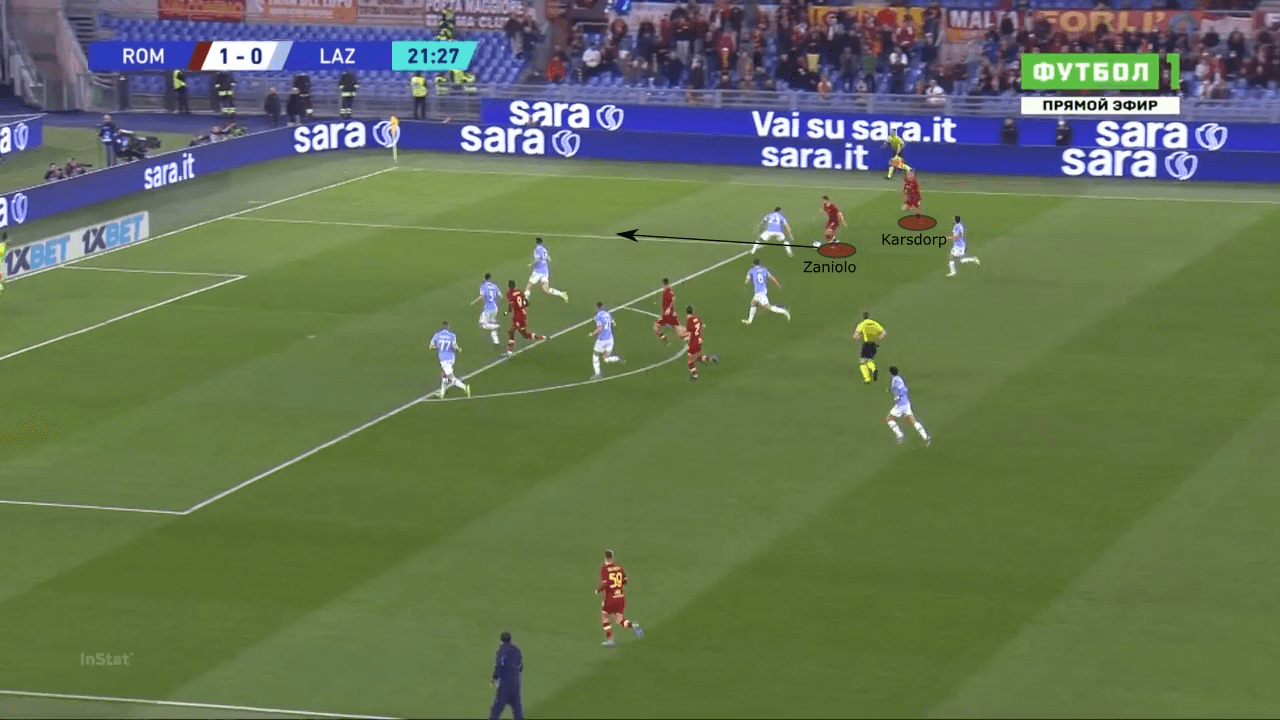
Karsdorp is able to find Abraham who easily creates space for himself and finishes it.
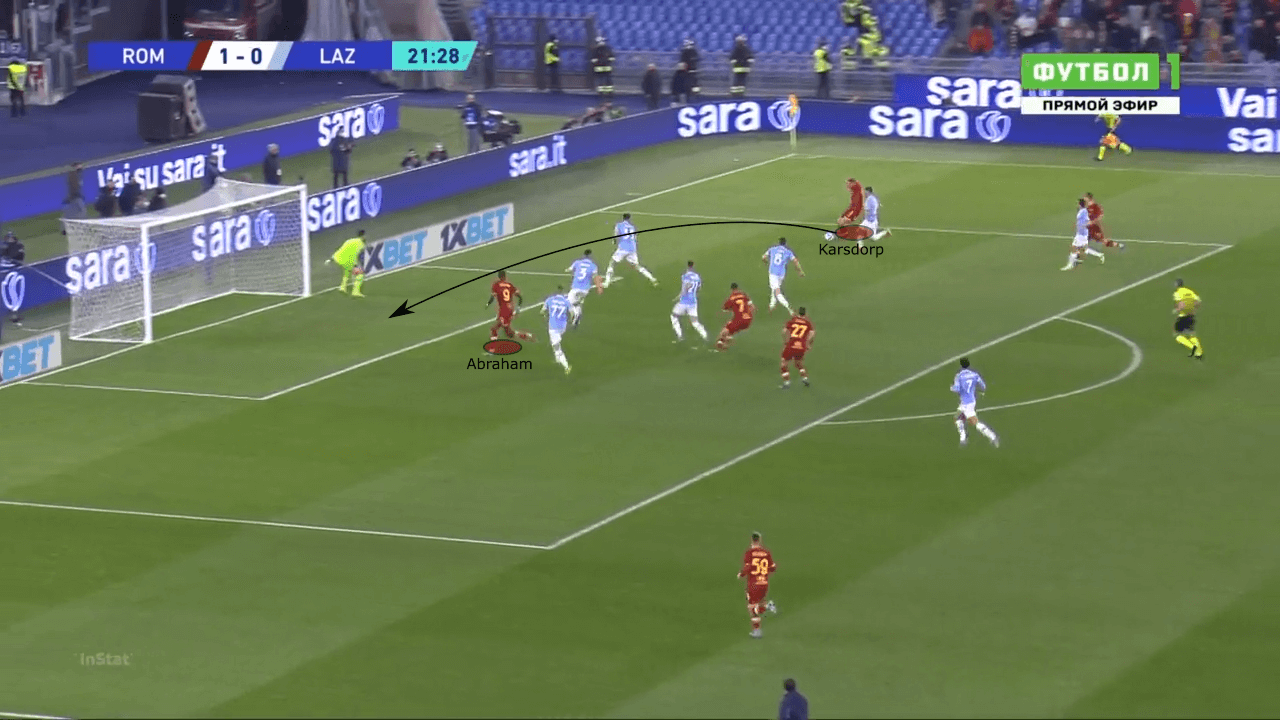
By exploiting Feyenoord’s high line and attacking the wide areas, Roma may find the edge in a very close battle. They will not have much time with the ball, so being efficient with it will prove to be decisive.
Conclusion
The first-ever UEFA Conference League final will be a very difficult battle between two extremely exciting teams. While both sides have very good attacks, their different approaches will most likely dictate the match one way. Feyenoord’s high press and possession-based approach will see them having more of the ball. With it, they will hope to exploit Roma’s midfield by manipulating spaces and disorganising the defensive structure. On the other hand, Roma will hope to be effective whenever they get the ball. Attacking the wide areas and exploiting Feyenoord’s high line may give them the edge. Nonetheless, it will be a very interesting battle between two extremely good managers.





Comments